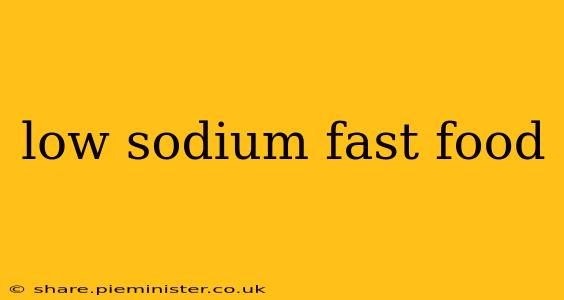Fast food is often associated with high sodium content, but for those watching their sodium intake due to health concerns like high blood pressure, finding low-sodium options can feel like navigating a minefield. This guide will help you make informed choices, allowing you to enjoy a quick meal without compromising your health goals.
What is considered low sodium?
The American Heart Association (AHA) recommends limiting daily sodium intake to less than 2,300 milligrams (mg), and ideally to no more than 1,500 mg for many adults, especially those with high blood pressure. Understanding portion sizes and reading nutrition labels carefully is crucial. A "low-sodium" food generally contains 140 mg or less of sodium per serving. Keep in mind that a single fast-food meal can easily exceed the recommended daily allowance if you're not careful.
What fast food chains offer low-sodium options?
Many major fast-food chains are now responding to consumer demand for healthier choices and are offering some low-sodium alternatives. However, "low-sodium" doesn't always mean "no sodium," and it's still important to be mindful of your total intake. Always check the nutrition information online or on in-restaurant displays. Some chains even allow for customization, such as requesting no salt added to your order.
How can I find low-sodium options at fast-food restaurants?
Here are some strategies for selecting lower-sodium items:
- Look for grilled options: Grilled chicken or fish sandwiches often have lower sodium content than fried options. The cooking method itself reduces the need for added salt.
- Choose salads (carefully): Salads can be a good choice, but be aware of high-sodium dressings and toppings. Opt for lighter dressings on the side, and hold the croutons and salty cheeses.
- Select plain items: Ordering plain items, such as a grilled chicken breast or a side of steamed vegetables, provides more control over sodium intake. You can then add low-sodium condiments or spices as needed.
- Check the nutrition information: Before ordering, always check the nutrition information online or at the restaurant. Look for items with sodium content under 500mg per serving. Many restaurants now have nutritional information readily available through their websites and mobile apps.
- Ask for modifications: Don't hesitate to ask for modifications to your order, such as "no salt added" or "light salt." Restaurant staff are often happy to accommodate reasonable requests.
Are there any fast food items naturally lower in sodium?
Some ingredients are naturally lower in sodium than others. Focusing your order on these ingredients can help reduce your overall sodium intake. For example, fresh vegetables and lean proteins are generally lower in sodium compared to processed meats or heavily seasoned dishes.
Can I prepare my own low-sodium fast food?
While not strictly "fast food," preparing some elements at home can drastically reduce sodium intake and offer a healthier alternative. Pack your own lunch or snacks, choosing items with lower sodium content, and supplement your fast food meal with these healthier choices.
What are some healthy substitutes for high-sodium fast food items?
Substituting high-sodium options with lower-sodium alternatives can make a significant impact. For example, instead of salty fries, try a side salad or fruit. Instead of a heavily seasoned burger, opt for a grilled chicken sandwich with a side of plain vegetables.
How can I manage my sodium intake when eating fast food?
Managing your sodium intake when eating fast food requires planning and awareness. By following the tips outlined above, making informed choices, and reading nutrition labels carefully, you can enjoy a fast-food meal without exceeding your daily sodium limit. Remember that even small changes can make a difference in your overall health.
Disclaimer: This information is intended for general knowledge and informational purposes only, and does not constitute medical advice. It is essential to consult with a qualified healthcare professional for any health concerns or before making any decisions related to your health or treatment. Nutritional information can vary between locations and menu changes, so always check the most up-to-date information from the restaurant itself.
